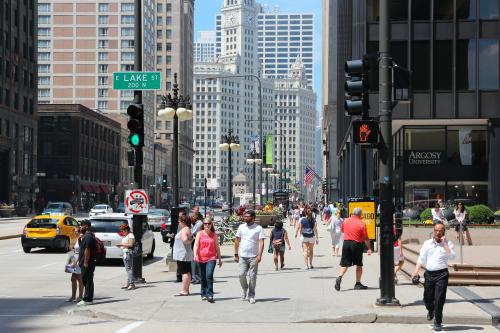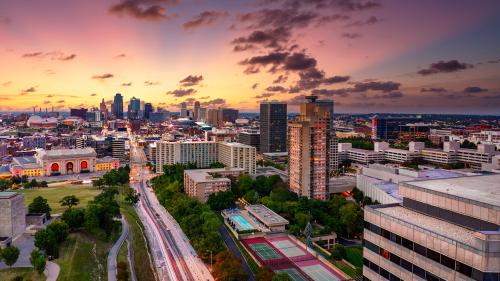Due to sample size differences, aggregated metropolitan-area employment estimates from the Current Employment Statistics (CES) program have a larger error term than national employment estimates derived from the same survey data. Our non-metropolitan employment share estimate—the residual between metropolitan and national employment—should therefore be interpreted as within a range of possible values, over- or under-stating the relative number of jobs in these areas. As additional sub-national 2017 data are made available, we will refine our analysis to improve the reliability of these findings.
Recently we noted the sharp divergence of large and small communities’ economic fortunes since the financial crisis. By that, we meant that growth across communities has tracked exactly with their size in recent years, ensuring that the nation’s biggest, bluest metropolitan areas generated outsized shares of the nation’s employment growth while smaller, redder towns and rural areas struggled.
Commented Washington Post’s Jennifer Rubin on the 2010 to 2016 trend: “America is winning, just not in places Trump voters live.”
But what about the most recent year—2017—the first year of the Trump presidency, a year of high interest given the president’s outsized claims about reversing the “carnage” he sees engulfing rural America.
As it happens, some of the relevant data are in and they suggest that the trends shifted somewhat (though not entirely) during President Trump’s first year in office. Table 1, for example, shows the share of national employment and employment growth from 2017, and reveals that the nation’s rural areas—home to 12.4 percent of U.S. jobs last January—actually had a pretty good year in 2017. Rural areas in fact outperformed their share of the economy to generate some 16.6 percent of the nation’s job growth.
Table 1. Share of national employment and employment growth, 2017
|
Share of national employment;
Jan, 2017 |
Share of national employment growth, 2017 |
|
| Metro areas | 87.6% | 83.4% |
| 1,000,000+ | 58.9% | 64.2% |
| 250k to 1,000,000 | 19.6% | 14.7% |
| <250k | 9.1% | 4.5% |
| Non-metro areas | 12.4% | 16.6% |
| United States | 100.0% | 100.0% |
Note: Seasonally-adjusted employment figures
Source: Brookings analysis of CES data
To be sure, the nation’s employment growth remained mostly a big-city affair in 2017, with nearly two-thirds—64.2 percent—of the nation’s job growth (the share is down a little from that of previous years) taking place in the 52 metros with more than 1 million residents and another 14.7 percent of the nation’s growth occurring in middle-sized city regions.
Yet, as Figure 1 shows, the rural uptick ensured a rural gain of over 320,000 jobs, with a surge in the second half of the year. This means that in 2017, only rural areas generated a larger share of the nation’s job growth than their starting job base would have predicted. In short, at least one core portion of Trump’s America finally won a little during his first year in office, which is good news for America’s troubled rural communities. Such growth may also be good for the battered Republican Party as it stumbles towards the mid-term elections.

Will the upturn last? Don’t bet on it. Not only does the bigger-is-better drift of the economy remain dominant—between 2010 and 2017 the largest metropolitan areas captured over three-quarters of national employment growth in contrast with rural areas’ 5.3 percent share—but the sources of the recent rural growth remain changeable. Many of the industries that added jobs in rural communities in 2017—such as logging, mining, oil and gas, and construction—remain cyclical given economic and commodity trends larger than any Trump-era deregulation drive or tax cut. At the same time, a slump in prices for corn, wheat, and other farm commodities over the past five years has cut total U.S. farm income in half, with further declines expected over the next decade. Equally worrisome, the types of physical or rote jobs prevalent in rural America remain disproportionately vulnerable to automation and globalization in a digital era that seems to favor the biggest, densest cities with their high education levels and powerful “agglomeration” economies.
Against that background, the rural job growth of 2017 is welcome but will likely be temporary for communities that will continue to struggle with world commodity price issues, a technological era that favors cities, and out-migration.
In that sense, it’s good news that small-town and rural America finally grew a little in 2017. But the fact remains that its long term economic development issues won’t likely be reversed anytime soon.
The Brookings Institution is committed to quality, independence, and impact.
We are supported by a diverse array of funders. In line with our values and policies, each Brookings publication represents the sole views of its author(s).








Commentary
In 2017, rural places won a little more, but will it last?
Tuesday, March 20, 2018